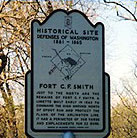
Fort C.F. Smith
2411 24th St. N.
Arlington, VA
After the land was colonized by the English, George Mason III purchased the land as part of a larger 2,000-acre parcel in the 1700's. By 1858 the land supported the Jewell family farmstead, which included a house called the "Red House," a barn, outbuildings, fields, and orchards. Then in 1863, during the Civil War, the Union Army appropriated the property and built Fort C.F. Smith. The fort and support structures, which were part of the Defense of Washington, were located at the northwest end of the Arlington Line protecting the Nation's Capital from Confederate advances. In 1865, the fort was decommissioned and the Jewell family returned and operated a small farm and nursery. Between 1888 and 1994, the land was owned by the Deming, Yates, Lindsay and Hendry families. Each owner made changes to the property, adding an orchard and cottage, building and enlarging the main house and expanding the gardens with trails, a summer house over the well, and many exotic plants and trees. As the site evolved, some elements were removed, including the summer house and orchard.
Fort C.F. Smith was constructed by Union Troops in early 1863. The fortification extended the line of Arlington forts to the Potomac River. Along with Forts Strong, Morton, and Woodbury, it functioned as part of the outer perimeter of defenses that protected the Aqueduct Bridge of the Chesapeake and Ohio Canal. The fort was a lunette with a southern and western face and two flanks, and two bastions on the north side to protect it from attack up the ravines form the Potomac. The fort was entered from the east by a road that crossed Spout Run and proceeded up the hill to Fort Strong. To provide clear lines of fire for Fort C.F. Smith and adjacent forts, all of the trees for miles around were cut down. Many of the trees were used in construction of the forts and support structures.
Located east of the fort were the support buildings were the troops ate and slept. The structures including the barracks, mess halls, cook houses, officers quarters, and barn and a headquarters building. When the fort was decommissioned in 1865, the structures were removed and no visible evidence of their existence remains today.
Located east of the fort were the support buildings were the troops ate and slept. The structures including the barracks, mess halls, cook houses, officers quarters, and barn and a headquarters building. When the fort was decommissioned in 1865, the structures were removed and no visible evidence of their existence remains today.
The earthwork ruins at this park are the best preserved ruins of the 22 forts that were located in Arlington during the Civil War. The ruins include the bomb proof, the fort well, the North magazine, and 11 of the 22 gun emplacements.
Communities and Related Links
|